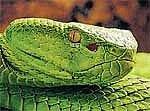
Researchers at the North Carolina State University in the US have also found that female pit vipers can conserve sperm after sex for at least five years, shedding light on the lengths these serpents can go to in order to procreate. Asexual reproduction is common among invertebrates — or the animals without backbones — and is rare in vertebrates, although it’s not unheard of.
Scientists have already found that komodo dragon, world’s largest living lizard, giving birth via parthenogenesis, in which an unfertilised egg develops to maturity. Such virgin births have also been seen in sharks, birds and amphibians. A boa constrictor has also been found having this ability.
Evolutionary geneticist Warren Booth of North Carolina State University and his colleague Gordon Schuett looked at a female copperhead. Over the past five years, she had come into contact with only one corn snake (Pantherophis guttatus) and interbreeding between the two species is considered unlikely or impossible. In 2009, this copperhead gave birth to a litter of four offspring that were outwardly normal in appearance, two of which were alive at birth.
DNA analysis from the mother, one live offspring and one of the stillborn progeny revealed no signs of genes from a father, suggesting a true virgin birth. “With the availability of DNA fingerprinting techniques, we are now becoming aware that the process of parthenogenesis is in fact more common than we ever imagined,” Booth said.
These snakes may have evolved parthenogenesis as a mechanism to fight a lack of suitable mates. “Instead of wasting eggs, which are costly to produce and a finite resource, parthenogenesis may represent an alternate means of reproduction to overcome this,” Booth said.